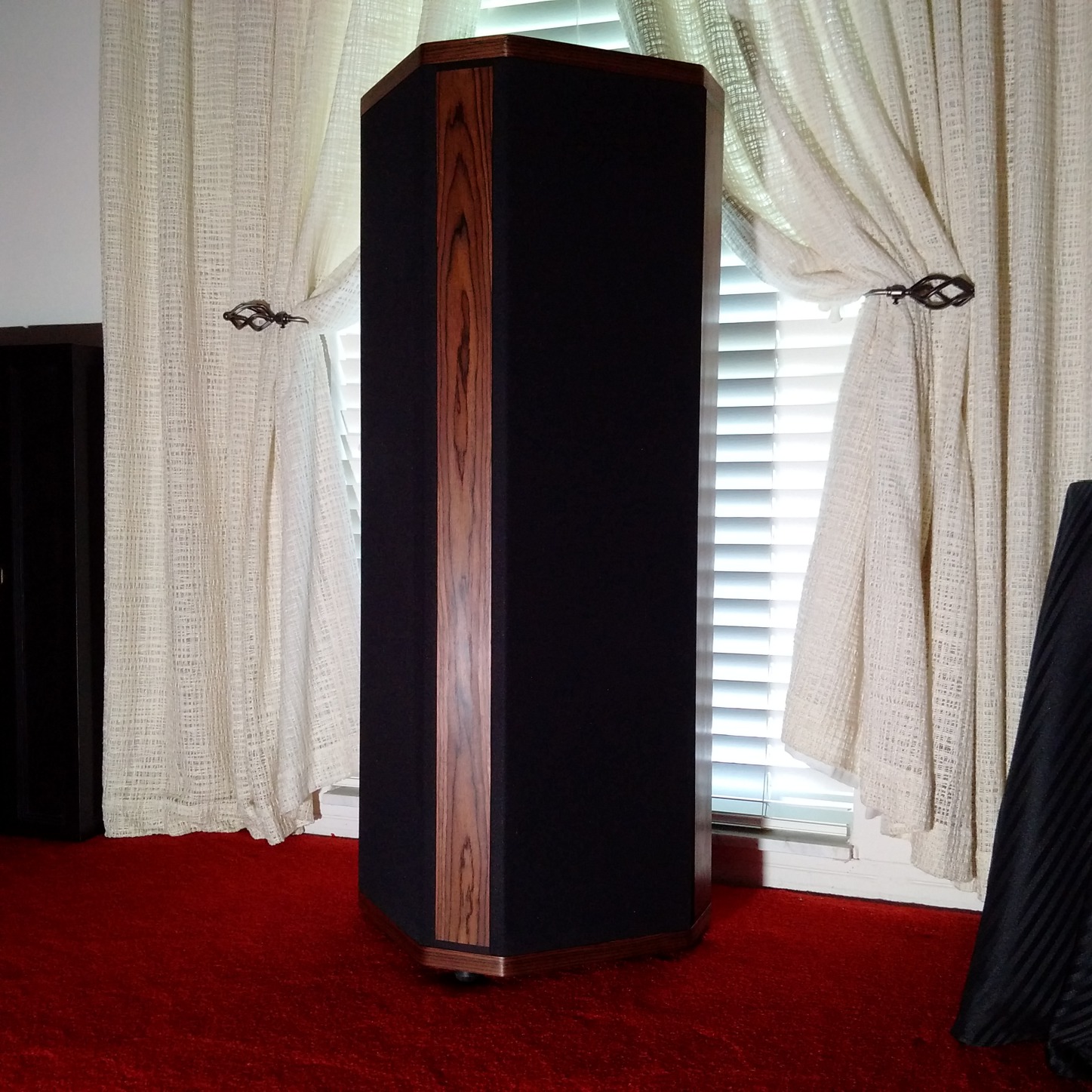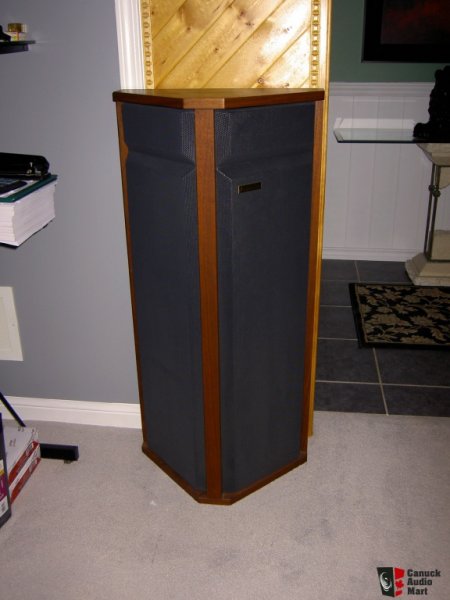The best speakers I heard at RMAF 2015 were ESP's new "Double-Bass" speakers in Room 510. Sean McCaughan is the designer and this just might be the most intelligent speaker design I've ever seen, a statement that I will try to explain shortly.
Here's what one looks like:

It's not as big as the photo's angle makes it seem... maybe 45 inches tall, I would guess. I think it's a "splayed array", with essentially full-range arrays firing off at 90 degrees to one another.
I walked into the room and two of these speakers were up against the side walls, "facing" one another across the width of the 13' wide by 19' long room. They were maybe 2/5 of the way down the 19' walls, from the end with the equipment rack. The "forward facing" arrays were criss-crossing approximately in the listening area, and the rear-facing arrays were criss-crossing over near where the electronics were set up (sorry, I don't have a photo of the room).
Immediately Beveridge lensed electrostatics came to mind - that's how Harold Beveridge recommended setting up his speakers. The technique never really caught on in the audiophile world, but those of us who got to hear a pair of Beveridges set up as he recommended remember it vividly to this day.
Well this was no mere coincidence - from what I understand, Sean used to work with Harold! That would explain in part the attention Sean's designs pay to getting the reverberant field right. Well with all due deference to the great Harold Beveridge designs of yore, I think the student has surpassed the teacher.
I think this was the best outside-the-center-sweet-spot soundstaging I have ever encountered. In this statement I'm including my experience as a SoundLab owner and dealer, builder of Earl Geddes's Summa, admirer (though not owner) of Beveridge speakers, and designer who gives off-axis imaging a high priority.
The timbre was beautiful. The bass gave no hint that we were in a crappy hotel room. If there were room treatments, I didn't notice them. I heard nothing that sounded anything other than holographic and magical. The soundstage may have stopped at the side walls, but it was deep and palpable so that didn't matter.
I suspect that Sean has enough directional control going on "under the hood" of his Double Bass speakers to improve on the image solidity of the Beveridges. That being said, these are not "audiophile fireworks laser-guided smart bomb" speakers. These are "ahhhh... I could listen to these forever!" speakers.
There is something else Sean's design is doing that most people probably wouldn't have picked up on, but because I'm working towards a similar goal (from another angle), it was apparent to me. There is something acoustic he's doing which plays magnificently into psychoacoustics. I'm not going to describe it because it may be a trade secret of his, and he deserves to not have it blabbed all over the internet by some loudmouth. So I hope you will just trust me when I say, in my opinion at least, this design is sheer genius.
Sean if you read this, I take off my virtual hat to you. If there is a speaker that interacts with the room (and with the ear/brain system) more intelligently and successfully than your Double-Bass, I don't think I've seen it.
The US distributor is Michael Vamos of Audio Skies in Los Angeles. I've never met him, but in my opinion his choice in speaker lines kinda speaks for itself.
If I wasn't doing my own speaker line, I'd be all over trying to become an ESP dealer. I'm a longtime SoundLab dealer, and the ESP Double-Bass is the first dynamic speaker I've heard that felt like it was in the same league.
Duke LeJeune
AudioKinesis
Here's what one looks like:

It's not as big as the photo's angle makes it seem... maybe 45 inches tall, I would guess. I think it's a "splayed array", with essentially full-range arrays firing off at 90 degrees to one another.
I walked into the room and two of these speakers were up against the side walls, "facing" one another across the width of the 13' wide by 19' long room. They were maybe 2/5 of the way down the 19' walls, from the end with the equipment rack. The "forward facing" arrays were criss-crossing approximately in the listening area, and the rear-facing arrays were criss-crossing over near where the electronics were set up (sorry, I don't have a photo of the room).
Immediately Beveridge lensed electrostatics came to mind - that's how Harold Beveridge recommended setting up his speakers. The technique never really caught on in the audiophile world, but those of us who got to hear a pair of Beveridges set up as he recommended remember it vividly to this day.
Well this was no mere coincidence - from what I understand, Sean used to work with Harold! That would explain in part the attention Sean's designs pay to getting the reverberant field right. Well with all due deference to the great Harold Beveridge designs of yore, I think the student has surpassed the teacher.
I think this was the best outside-the-center-sweet-spot soundstaging I have ever encountered. In this statement I'm including my experience as a SoundLab owner and dealer, builder of Earl Geddes's Summa, admirer (though not owner) of Beveridge speakers, and designer who gives off-axis imaging a high priority.
The timbre was beautiful. The bass gave no hint that we were in a crappy hotel room. If there were room treatments, I didn't notice them. I heard nothing that sounded anything other than holographic and magical. The soundstage may have stopped at the side walls, but it was deep and palpable so that didn't matter.
I suspect that Sean has enough directional control going on "under the hood" of his Double Bass speakers to improve on the image solidity of the Beveridges. That being said, these are not "audiophile fireworks laser-guided smart bomb" speakers. These are "ahhhh... I could listen to these forever!" speakers.
There is something else Sean's design is doing that most people probably wouldn't have picked up on, but because I'm working towards a similar goal (from another angle), it was apparent to me. There is something acoustic he's doing which plays magnificently into psychoacoustics. I'm not going to describe it because it may be a trade secret of his, and he deserves to not have it blabbed all over the internet by some loudmouth. So I hope you will just trust me when I say, in my opinion at least, this design is sheer genius.
Sean if you read this, I take off my virtual hat to you. If there is a speaker that interacts with the room (and with the ear/brain system) more intelligently and successfully than your Double-Bass, I don't think I've seen it.
The US distributor is Michael Vamos of Audio Skies in Los Angeles. I've never met him, but in my opinion his choice in speaker lines kinda speaks for itself.
If I wasn't doing my own speaker line, I'd be all over trying to become an ESP dealer. I'm a longtime SoundLab dealer, and the ESP Double-Bass is the first dynamic speaker I've heard that felt like it was in the same league.
Duke LeJeune
AudioKinesis
Last edited:














